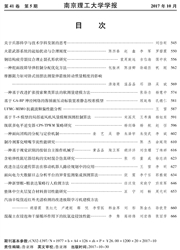

 中文摘要:
中文摘要:
为了能够进一步理解分子结构和分子之间相互作用对热激活延迟荧光(Thermally activated delayed fluorescence,TADF)材料光物理过程的影响,该文研究了TADF材料2,4,5,6-四(9-咔唑基)-间苯二腈(2,4,5,6-tetrakis(carbazol-9-yl)-1,3-dicyanobenzene,4Cz IPN)和2,3,5,6-四(3,6-二苯基-9-咔唑基)-对苯二腈(2,3,5,6-tetrakis(3,6-diphenylcarbazol-9-yl)-1,4-dicyanobenzene,4Cz TPN-Ph)薄膜在不同温度下的发光光谱。发现对于4Cz IPN薄膜,在280 K附近,随着温度的增加,发光强度有反常增加的现象,该现象被归因于4Cz IPN分子之间的相互作用在该温度下变弱。同时,在分子结构稍有不同的4Cz TPN-Ph中,没有观察到类似现象。研究结果表明:分子结构可以用来调控薄膜中分子相互作用对发光过程的影响,从而进一步提高有机发光二极管的效率。
 英文摘要:
英文摘要:
In order to understand the influence of molecular structure and molecular interaction on the light physical processes of the thermally activated delayed fluorescence emitter, photolumineseenee spectroscopy of thermally activated delayed fluorescence (TADF) emitter, namely, 2,4,5,6-tetrakis ( carbazol-9-yl ) -1,3 -dicyanobenzene ( 4CzIPN ) and its derivative, 2,3,5,6-tetrakis (3,6-diphenylcarbazol-9-yl) -1,4-dieyanobenzene ( 4CzTPN-Ph ) are studied. In 4CzIPN film, the photoluminescence intensity increases unexpectedly when temperature increases at 280K, which is ascribed to be the thermally weakening of molecular interaction. On the contrary, no such phenomenon is observed in 4CzTPN-Ph film. The results indicate that the molecular structure can be modified to adjust to molecular interaction's influence on photoluminescence processes, in order to enhance the efficiency of corresponding light emission diodes.
 同期刊论文项目
同期刊论文项目
 同项目期刊论文
同项目期刊论文
 期刊信息
期刊信息
